| Structure | Name/CAS No. | Articles |
|---|---|---|
 |
1H-Indole-3-carboxylic acid
CAS:771-50-6 |
|
 |
Indole-2-carboxylic acid
CAS:1477-50-5 |